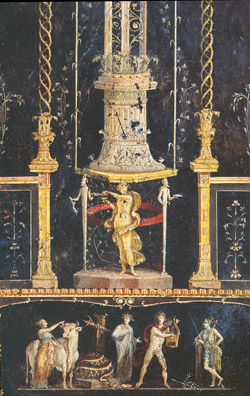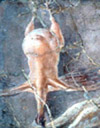
HOUSE OF THE VETTII - POMPEII

This luxurious residence houses an impressive collection of fresco decorations typical of the wall paintings in the houses of rich Pompeian traders. The excavation techniques used made it possible to preserve, in almost all the rooms in the complex, the fourth style figure paintings completed after the earthquake of 62 A.D.. The brothers Aulus Vettius Restitutus and Aulus Vettius Conviva commissioned their fresco decorations from one of the leading artists’ workshops so that their home would be not only a comfortable residence, but also a “status symbol”. The house is divided into two areas: firstly, the part in which the family lived, laid out around the main atrium and the peristyle with its beautiful garden (this house does not have the tablinum which was traditionally built between the two, opposite the main entrance); and secondly the part where the servants lived and worked, on the right of the entrance hall and centred around a small atrium with a lararium. The wall facing the entrance is decorated with a fresco of Priapus weighing his phallus on a pair of scales and a sheep with the attributes of Mercury, the god of financial income, which here serve to protect the house from bad luck and as propitiatory symbols of wealth. The atrium is decorated with scenes depicting sacrifices, hunts and cupids while two strong-boxes are anchored to stone block in the floor. The decision to site them here can probably be explained by the desire of the master of the house to underline their wealth and importance. The rooms laid out on the left of the entrance hall are decorated with mythological subject, which are described below. On the right-hand wall in the first room we can see a fresco depicting the myth of Leander swimming towards his beloved Hero, while the opposite wall portrays Ariadne abandoned Theseus on Naxos. The next room is decorated with frescoes depicting the struggle between Cupid and Pan, Cyparissus who transformed into a cypress tree after killing a sacred stag and, lastly, some images of Jupiter in the upper section of the wall. The two rooms (alae) opening off the atrium just before it leads into the garden have frescoes painted on a yellow background; these depict a cock fight on the left, and two medallions portraying the heads of Medusa and Silenus on the right. The peristyle is decorated with black panelling with alternate still life and figure paintings. The garden has been mostly rebuilt according to its original layout and was lavishly decorated with bronze and marble statuettes of cherubs and cupids, busts and head on columns, tables, rectangular marble fountains along the four sides and round fountains in the four corners and in the centre. Along the side of the peristyle facing the atrium, we find two reception rooms that open onto the garden and are lavishly decorated with frescoes of mythological scenes set inside painted aediculae. The living room on the left just beyond the atrium has yellow painted walls with frescoes depicting: Hercules strangling the serpents sent by Juno; the punishment of Dirce bound to the horns of a raging bull by Amphion and Zetus; the suffering of Pentheus torn limb from limb by the Bacchantes. The living room on the right just beyond the atrium is decorated with a lower section of imitation coloured marble while, amidst an architectural flight of fancy, we can see: Daedalus presenting Pasiphae with the wooden cow in which she would hide as she was in love with a bull, and from whose union she was to give birth to the Minotaur; the punishment inflicted on Ixion who is tied to a wheel built by Hephaestus and made to turn for all eternity as Hera sitting on the throne and Hermes look on; Bacchus watching Ariadne as she sleeps. Leaving the living room and following the peristyle we find a few rooms set to one side and thought to have been reserved for women (gynaeceum), where we can see a triclinium and a cubiculum opposite a small garden. The triclinium runs in the same direction as the garden (which has been planted with the original aromatic herbs) and houses an extremely unusual miniaturised decoration above a lower panel. This portrays cupids and their female equivalents (psyches) engaged in a number of different activities. The figure paintings which were here fastened to the wall by nails are now missing while the vermillion side panels depict well-known divine couples in flight: Perseus and Andromeda, Dionysus and Ariadne, Apollo and Daphne, Neptune and Amymone and Silenus astonished by Hermaphroditos. Leaving the residential part of the house through a doorway beside the main entrance, we come into the area where the servants worked and lived. In the small atrium we find the lararium, the altar to the domestic gods, on which we can see a scene depicting the Genius with two Lares dancing on either side above a serpent, the symbol of regenerative power.





